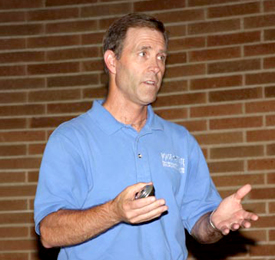
| CONNECTIONS |
IDAHO
ITD
HOME
511 TRAVEL SERVICES
IDAHO
DMV
ITD
NEWS
HIGHWAY
SAFETY
IDAHO STATE POLICE
STATE OF IDAHO
NIATT
NATIONAL
AASHTO
AAMVA
AAA of IDAHO
FEDERAL HIGHWAYS
FEDERAL AVIATION
IDAHO STATE POLICE
NHTSA
NTSB
TRB
U.S. DOT
TRANSPORTER
Archives
Milestones
Comments
Idaho
Transportation
Department
Office of Communications
P.O. Box 7129
Boise, ID 83707
208.334.8005
Fax: 208.334.8563

Silent killer lurks above the surface of summer fun
It is easy to grasp the danger of carbon monoxide in a closed environment like a garage or well-sealed home. Less apparent are risks that invisible, odorless, tasteless and non-irritating gas pose to recreational watercraft users.
 Dale Stephenson didn’t understand carbon monoxide risks associated with boating until about a year ago, but now, getting the message out about those risks has become his passion.
Dale Stephenson didn’t understand carbon monoxide risks associated with boating until about a year ago, but now, getting the message out about those risks has become his passion.
On July 15 and 16 he brought that message to ITD Headquarters personnel in a presentation titled “Carbon Monoxide, Watercraft, and Drowning – Saving Smiles by Spreading the Word,” sponsored by the HQ Safety Committee.
Stephenson is a professor and academic director of Environmental and Occupational Health at Boise State University.
From 1994 to 2004, 72 people drowned in Lake Powell, a reservoir on the Colorado River that straddles the border between Utah and Arizona. Twenty-five of the 72 deaths were the result of boating accidents, according to National Park Service records.
Nearly half of the 25 boat-related drownings were linked to carbon monoxide poisoning.
Most of those drownings occurred near the back of watercraft where swimming, “Teak Surfing” or “Platform Dragging” take place, Stephenson said. Houseboats harbor their own “Death Zone” beneath the swim platform, which is often located near the boat exhaust at the rear of the watercraft.
These locations can contain lethal amounts of carbon monoxide, Stephenson said. A typical boat engine generates an amount of carbon monoxide equal to 188 cars. Boats are not required to have emission controls.
Sometimes called the “silent killer” carbon monoxide, or CO, can be fatal in even small amounts. It kills by suffocation, replacing oxygen in the bloodstream. Symptoms include flu-like or seasickness nausea, headache, dizziness, fatigue, lack of coordination and drowsiness.
At a concentration of 87 parts carbon monoxide per million parts of air, the World Health Organization recommends limiting CO exposure to no more than 15 minutes. Increase that concentration to 1,200 parts per million (ppm) and the danger to life and health is immediate. Exposure to a CO level of 12,800 ppm can lead to death in one to three minutes.
 Boat generators and propulsion engines can produce carbon monoxide levels ranging from 30,000 ppm to 60,000 ppm. The gas is heavier than air so it remains close to the water surface.
Boat generators and propulsion engines can produce carbon monoxide levels ranging from 30,000 ppm to 60,000 ppm. The gas is heavier than air so it remains close to the water surface.
A ski boat can generate a CO count from 33,800 ppm at one inch below the ski platform to 426 ppm at 18 to 20 inches above the water as far as 10 feet from the stern of the boat.
At head height, the CO count can reach as high as 1000 ppm in a boat passenger seat.
Carbon monoxide always has been present in the atmosphere, chiefly as a product of volcanic activity and naturally occurring bushfires. CO is a byproduct of the fuel-burning process.
Stephenson talked about the tragic death of the Dixey boys, two brothers who succumbed to CO poisoning during a houseboat vacation with their parents on Lake Powell in 2000. The story and its impact was told by the Arizona Republic in an article titled “The last swim; boys' deaths expose invisible killer.”
“CO exposure is completely preventable,” Stephenson said.
Recognition is the key to prevention, he explained. If a drowning is anywhere near a boat with an engine: think CO; ask about CO-related factors; and seek a blood analysis.
Prevention involves engineering controls like designing watercraft with side exhaust, education, and legislation or regulation. Harbors and channels should be monitored regularly for CO counts and closed when levels reach prolonged unhealthy or hazardous conditions.
Finally, report any recognized CO-related drowning to the appropriate agency – state boating law administrator, state parks, state fish and game, sheriff, etc.
Published 7-18-8